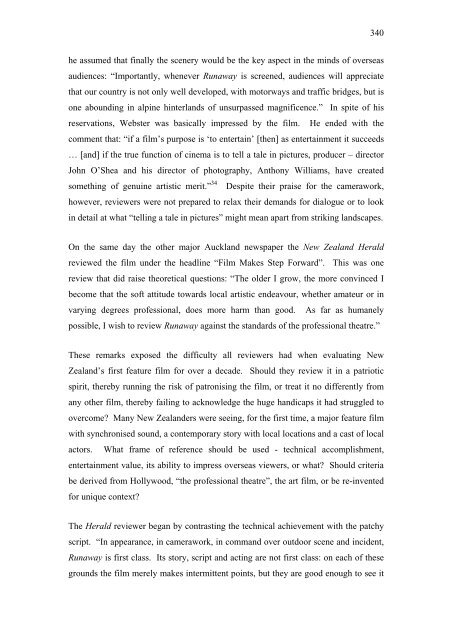Copyright Statement - ResearchSpace@Auckland
Copyright Statement - ResearchSpace@Auckland
Copyright Statement - ResearchSpace@Auckland
You also want an ePaper? Increase the reach of your titles
YUMPU automatically turns print PDFs into web optimized ePapers that Google loves.
340<br />
he assumed that finally the scenery would be the key aspect in the minds of overseas<br />
audiences: “Importantly, whenever Runaway is screened, audiences will appreciate<br />
that our country is not only well developed, with motorways and traffic bridges, but is<br />
one abounding in alpine hinterlands of unsurpassed magnificence.” In spite of his<br />
reservations, Webster was basically impressed by the film. He ended with the<br />
comment that: “if a film’s purpose is ‘to entertain’ [then] as entertainment it succeeds<br />
… [and] if the true function of cinema is to tell a tale in pictures, producer – director<br />
John O’Shea and his director of photography, Anthony Williams, have created<br />
something of genuine artistic merit.” 34 Despite their praise for the camerawork,<br />
however, reviewers were not prepared to relax their demands for dialogue or to look<br />
in detail at what “telling a tale in pictures” might mean apart from striking landscapes.<br />
On the same day the other major Auckland newspaper the New Zealand Herald<br />
reviewed the film under the headline “Film Makes Step Forward”. This was one<br />
review that did raise theoretical questions: “The older I grow, the more convinced I<br />
become that the soft attitude towards local artistic endeavour, whether amateur or in<br />
varying degrees professional, does more harm than good. As far as humanely<br />
possible, I wish to review Runaway against the standards of the professional theatre.”<br />
These remarks exposed the difficulty all reviewers had when evaluating New<br />
Zealand’s first feature film for over a decade. Should they review it in a patriotic<br />
spirit, thereby running the risk of patronising the film, or treat it no differently from<br />
any other film, thereby failing to acknowledge the huge handicaps it had struggled to<br />
overcome? Many New Zealanders were seeing, for the first time, a major feature film<br />
with synchronised sound, a contemporary story with local locations and a cast of local<br />
actors. What frame of reference should be used - technical accomplishment,<br />
entertainment value, its ability to impress overseas viewers, or what? Should criteria<br />
be derived from Hollywood, “the professional theatre”, the art film, or be re-invented<br />
for unique context?<br />
The Herald reviewer began by contrasting the technical achievement with the patchy<br />
script. “In appearance, in camerawork, in command over outdoor scene and incident,<br />
Runaway is first class. Its story, script and acting are not first class: on each of these<br />
grounds the film merely makes intermittent points, but they are good enough to see it















